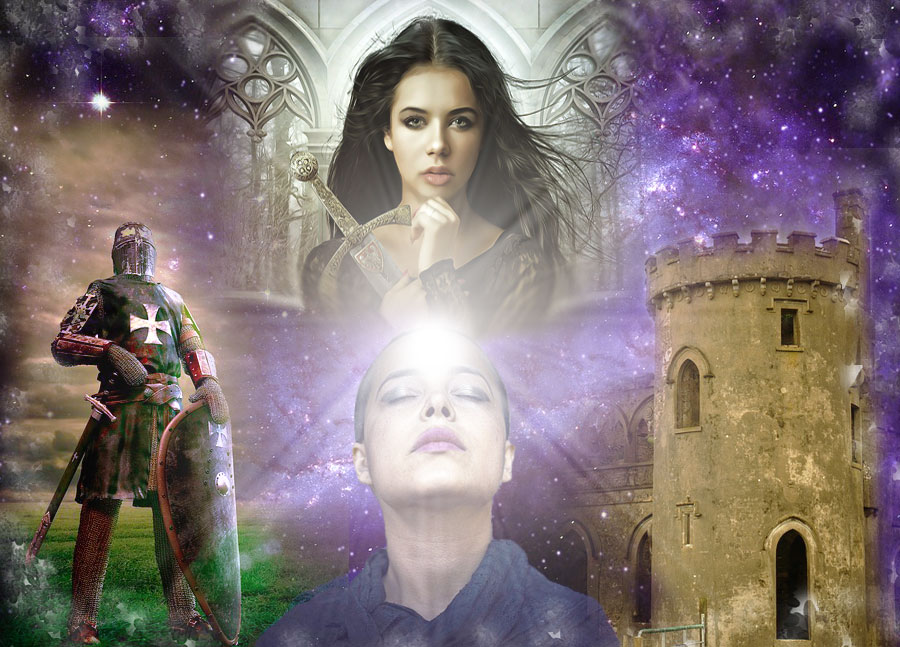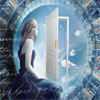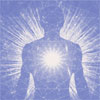Spontaneous Recall Of Past Lives
 by Rosemary Ellen Guiley
by Rosemary Ellen Guiley
Just before we are reborn, the veil of forgetfulness descends to block our remembrance of our past lives. We come into life with a karmic history and a purpose, yet we have conscious access to neither. According to Eastern doctrine, forgetfulness is a blessing and enables the soul to make a fresh start in each incarnation. Otherwise, life would be made extremely complicated and confusing, perhaps even paralyzing. Nonetheless, we catch glimpses of the past in certain moments. Fragments and fleeting impressions and feelings bubble to the surface, only to be passed off as imagination in many instances. In some cases, a person may be swept into an incredible vision that unfolds before their eyes. There are many ways to experience past lives spontaneously:
Deja Vu
Deja vu is an unexpected and unexplained feeling of familiarity in relation to places, events, people, dreams and all manner of experiences. A French term for which there is no exact English equivalent, deja vu generally means “already seen.” It is a common experience: you meet someone for the first time, yet feel you have known them before; you visit a strange place for the first time and feel oddly at home. Deja vu varies in intensity, from vague feelings of familiarity to specific knowledge, such as how to get around a strange city, or the location of hidden objects in a strange place.
Many scientific theories have been advanced since the latter nineteenth century to explain the phenomenon, yet none have been adequate. Perhaps the best explanation is that deja vu is the surfacing of fragments of past-life memories. Carl G. Jung once had a powerful deja vu experience. During his first trip to Africa, he traveled by train along the rugged coastline from Mobassa to Nairobi. Looking out the window one dawn morning, he saw a steep red cliff on which a lone black man stood, leaning on his spear, watching the train. Jung felt an intense deja vu.
He wrote in his memoir, Memories, Dreams, Reflections, “I had the feeling that I had already experienced this moment and had always known this world which was separated from me only by distance in time. It was as if I were this moment returning to the land of my youth, and as if I knew that dark-skinned man who had been waiting for me for five thousand years.” The curious sensation of familiarity lasted with Jung throughout the rest of his journey through Africa. He called the feeling a “recognition of the immemorially known.”
Waking Visions And Intuitive Flashes
Visions and flashes of past lives can arise during waking consciousness, triggered by deja vu, meeting someone which whom one has a karmic tie, visiting a place tied to a past life, hearing music or even seeing art that has a past-life meaning for the individual.
The visions may flash quickly across the mind’s eye or may appear as hallucinations, in which the present surroundings disappear and are replaced by scenes from the past, and the viewer literally feels transported to another time and place. All the senses are engaged, and for a few brief moments, they relive the past.
Sometimes the past-life connection is sensed merely as an intuitive “knowing.” Intuition, the power to know without conscious reasoning, plays an ancillary role in past-life recall, reinforcing what one experiences through other forms mentioned here. Intuitive flashes can provide supplemental details to a recall and insight into karmic situations.
In his book Lifetimes, Frederick Lenz formulated a model for a waking vision recall, based on his interviews with 127 persons. A person is engaged in a normal activity, and becomes aware of a high-pitched ringing or buzzing in one or both ears. The noise escalates until all other noises are blocked out. His body becomes light. His surroundings begin to change, becoming hazy and wavy as though everything around him is vibrating. Colored lights may pass before his eyes. He feels ecstatic. Strange scenes begin to appear, as though he is watching a movie. At some point, he realizes he is no longer watching the movie, but participating in it. His consciousness may alternate back and forth between that of viewer and participant. Eventually, the scenes fade and he becomes aware of his body once again.
Lesser phenomena associated with waking visions include an awareness of being out-of-body during the experience, and being guided by a voice or angelic being. In a nonjudgmental fashion, the guide presents an overview of the past.
In some cases, individuals see more than one life. The guide presents an overview of many lifetimes, from a few to hundreds. The lives are laid out like a string of beads or pearly globes, or are strung out like photographs. They flash by quickly yet are completely understood by the witness, who feels an amazing capacity to absorb tremendous amounts of “knowing” in some sort of telepathic fashion. It becomes instantly clear what has and has not been learned through a series of lives. While witnesses can see the positive things, more often than not the review serves as a helpful prod to quit wasting time mired in hate, jealousy, greed, apathy and other negative conditions and get on with spiritual development.
Dreams
Some investigators of reincarnation have found dreams to comprise one of the most common sources of past-life recall. Jung was skeptical about reincarnation yet investigated it, looking for empirical evidence which would prove the doctrine to him. He found nothing—deja vu was not empirical—until he had a series of dreams “which would seem to describe the process of reincarnation in a deceased person of my acquaintance,” as he wrote in Memories. “But I have never come across any such dreams in other persons, and therefore have no basis for comparison… I must confess, however, that after this experience I view the problem of reincarnation with somewhat different eyes…”
Past-life dreams may occur once in a great while or with great frequency. Distinguishing past-life dreams from ordinary ones is not always easy. Individuals who have experienced many past-life dreams learn to recognize them by the impressions they create. Such dreams usually are extremely vivid and clear, and remain sharp in the memory for a long time. Many are lucid, in which the dreamer is aware he or she is dreaming, perhaps even knowing the dream is a past life. Recurring dreams often have past-life connections. Interpreting such dreams often requires the help of a therapist who specializes in past-life recall. Dreams should be recorded in a notebook or journal immediately upon awakening.
Past-life information also can surface in the twilight periods at either end of the sleep cycle: the hypnagogic state, which occurs as we drop off to sleep, and the hypnopompic state, which occurs as we rise back to wakefulness. In these states, when the brainwaves are drifting down through theta toward the delta levels of sleep, we experience reveries of snatches of images and voices. They usually seem like a jumble, and perhaps are the conscious mind clearing itself for sleep. Some of the reveries may contain psychic or past-life information which is not filtered out by the conscious mind.
Spontaneous Memories
The ability to remember a past life spontaneously, as though it were just another memory like yesterday or the day before, is rare, but from a scientist’s point of view, is quite significant. Spontaneous recall almost always occurs in children between the ages of about two and four. By age three, children have learned enough vocabulary skills to describe, even in rough fashion, what they remember. By age eight, the past-life memories begin to fade or are already obliterated by the memories accumulated in the present life.
Scientists view spontaneous recall as significant because in many such cases, children talk about places, things and people they have no way of knowing; they exhibit knowledge and skills they have not been taught; and they often can identify people, places and things from the deceased personality’s life. In the eyes of science, these cases constitute the strongest evidence in support of reincarnation, but do not necessarily prove reincarnation.
In contrast, an adult who experiences spontaneous recall might possibly be drawing subconsciously upon dozens of sources “forgotten” by the conscious mind, such as old memories of experiences, books and movies. In addition, scientists posit that extrasensory skills might also come into play, including picking up information through clairvoyance or telepathy.
Ian Stevenson, one of the world’s leading experts on reincarnation and former chair of psychiatry at the University of Virginia in Charlottesville, investigated reincarnation cases from the 1960s until his death in 2007. He collected more than 2,000 cases. Not surprisingly, most of them are in Eastern countries where religious beliefs support reincarnation or rebirth.
Stevenson said that Western cases are few because parents typically ignore or discourage a child’s utterances about a previous existence, or chalk them up to imagination. To verify a claim, Stevenson undertook a lengthy and painstaking investigation, visiting the child and his family, the family of the deceased, and others who could verify the claim. A case was “solved” when Stevenson and his associates were satisfied that a child’s statements did refer to an identifiable dead person.
A high incidence of Stevenson’s cases involved violent death. The children often remembered quite well how they died. They may have had birthmarks coinciding with the place of the death wound, and phobias related to the means of death, such as a fear of water due to drowning.
In such cases, the intense emotion and trauma generated by a violent death probably makes it easier for such memories to surface. The interval between the death and the reincarnation often is short, sometimes less than the gestation period of nine months, perhaps indicating that the soul is not necessarily inhabiting a fetus from conception. In Eastern belief, individuals who suffer violent death are granted the opportunity to be reborn quickly, in order to finish out their karma.
The Resonance Method
A resonance is a sound which continues in the ear or memory; we say that something is resonant if it has a prolonged, subtle or stimulating effect beyond the initial impact. The same may be said for past lives: they continue to resonate into the present in a multitude of ways both dramatic and subtle.
A means for discovering these resonances, the Resonance Method, was developed by author Michael Talbot. In his book Your Past Lives: A Reincarnation Handbook, Talbot defined past-life resonances as “an inexplicable tugging at your heart strings, a special draw that you feel toward some things and not others when there is no logical reason in this life for you to feel the way you do.” Resonances occur in natural affinities for places, things, cultures, races, periods in history, foods, hobbies, occupations, styles of music and art, clothing, religions, languages and climates. Resonances also surface in dreams, daydreams, inspired thoughts, deja vu and what Talbot called an innate “bedrock knowing.” They may be discovered in personality traits and relationships with animals and people. Even dislikes and aversions are resonances. In an interview for this book, Talbot explained:
We have enormous contact with our past-life memories, but they are separated from us by a thin film, so we don’t know they are memories. They surface in the form of resonances. I think most resonances have past life echoes to them. You can’t take a single resonance and say, ‘This is a past life memory,’ but they do piece together if you keep lists of them. It’s like putting together a giant jigsaw puzzle on a table— none of the pieces makes any sense until all of them come together in a larger constellation of information. When I started developing the Resonance Method, it was astonishing to me how well this works.
The Resonance Method was itself a kind of resonance. I think I always knew it. I was thinking about what I felt resonances for, and the question occurred to me, ‘I wonder if I’ve ever lived in Berlin?’ I immediately had this feeling, not really. I was startled that I knew the answer just like that. So, I started asking myself questions and realized there were lots of things in me that I had always known…
When you ask yourself questions about resonances, you don’t try to intellectually answer them. We are all incredibly psychic. There is a knowing within us that is below all the chatter in our head, and it will give us answers to questions. Just ask and listen.
One method I use a great deal is I tell myself I am going to remember. The way we process our earth memories is through contact with our unconscious, and one of the most powerful ways we have that contact is through habit. You establish the habit of remembering… Ian Stevenson said that when you investigate [reincarnation] you have to be a lawyer, an historian and a psychologist. That is what I always recommend to people. You have to be all those three things, and you cannot jump to conclusions.
Talbot recommended recording resonances in past-life journals or on index cards. Jot them down when they occur to you. Ask yourself questions about places, things, etc., and note down the answers that automatically arise. Besides their spontaneous occurrence, resonances may be coaxed through a variety of ways, including divination, psychic readings, hypnosis, guided meditation and other forms of enhanced recall.
Before he died in 1992, resonances helped Talbot discover at least twenty past lives in varying detail. His own resonances began early in childhood, when he became aware that he possessed memories that were part of other lives. Up until age five, he refused to call his parents “father” and “mother” but addressed them by their first names instead. He was strongly drawn to the Asian culture, including a fondness for strong black tea and sitting cross-legged on the floor. Before going to bed, he recited the traditional child’s prayer, “Now I lay me down to sleep…” but added a Buddhist ending, asking God “to release the suffering of all conscious beings.”
When Talbot was older, he explored fragments of memories and his resonances with the Far East and, with the help of a psychic, discovered past lives as a Buddhist monk. One involved death by drowning:
One of my earliest memories was drowning. I remember drowning twice. In one memory, I was out in the open sea and there was a ship involved. In the other, land was in sight where I drowned. In the second memory, I looked up, knowing I was drowning, and saw the surface of the water without being able to reach it. I could see the faces of men looking down at me through the water. They were dark complected and had on orange robes, and they were bald. As I grew older, I realized they were monks of some kind. I was puzzled. Who were these men? For a while, I thought I had been ritualistically drowned. I was always looking for some account of ritualized drowning in different cultures and never found it. I was angry towards that memory. Why did they let me drown?
When I had my first reading with [psychic] Jim Gordon, I told him I thought I had drowned before. He said I had drowned twice. One time I was on a ship. It didn’t seem to be significant, and it didn’t have that much emotional or psychological impact for me. The second time did. I was a monk in India. I knew I’d lived in India before and that I’d been very religious, if not a monk, because I have such a strong feeling for Hinduism and Buddhism and for India in general.
In this past life I was a Buddhist monk. There was a storm, a terrible monsoon, and I sought refuge in a Hindu ashram. They would not let me in because I was Buddhist. I kept walking and got lost in the storm. I fell off of a precipice into the ocean and drowned. Gordon said I have held a great deal of resentment toward those monks even in this life, and this is why I held onto the image of them in my mind as I died…
One could make the argument that a psychic is just telepathically picking up on your fantasies. But Gordon took a story that I had in my mind, had a different interpretation and made it make more sense. If he was merely telepathic, at the very least it would mean that I myself did not know all the story. It was something spun by my unconscious mind that he had to bring out for me.
Resonances act as powerful triggers to past-life memories. Past lives which have the greatest resonance with the present life, in terms of emotions, events and circumstances, are the most likely to be recalled.
Illness And Accident
Severe illness, especially involving high fever, delirium and coma, sometimes induce past-life recall. Accidents involving severe trauma, especially to the head as in concussions, also jar loose past-life memories. In 1907, three year-old Dorothy Eady of London tumbled down a flight of stairs and was pronounced dead by a doctor. An hour later, the child was revived completely and seemed to suffer no injuries or ill effects from her terrible fall.
However, Eady soon began having strange dreams of a large building with columns and an exotic garden. She cried that she was not “home,” but didn’t know where “home” was. On a visit to the British Museum, the child was excited by Egyptian artifacts, and declared she had found her people. By age seven, she identified the building in her dreams as the temple of Sety the First, pharaoh of Egypt in the Nineteenth Dynasty, who lived from 1306-1290 B.C.E. As she grew older, she pursued an intense study of Egyptian history. Her story is chronicled in the book, The Story of Omm Sety by Jonathan Cott.
In 1918, she awoke one night to see a face bending over her—the face of the mummy of Sety. The hands and arms of the figure moved, but it said nothing. After that, she began having a recurring dream in which she was a young Egyptian girl who was beaten with a stick for refusing to answer questions. Gradually, she discovered that she and the pharaoh, who was in his early fifties, had been passionate lovers. She was a fourteen year-old orphan, Bentreshyt (“Harp-of-Joy”), who served as a priestess of Isis in Sety’s temple at Abydos, the building she had seen so often in her dreams. At age twelve, she took vows to remain a virgin and be temple property. She fell in love with Sety, however, and became pregnant by him. The temple high priest tried to beat the truth out of her, but rather than reveal it, she took her own life.
Eady instinctively knew that in order to contact the spirit of Sety, she would have to move to Egypt. At the age of twenty-nine, she married an Egyptian man and went to live in Cairo. She had visions and saw ghosts at many Egyptian ruins. She worshiped the ancient Egyptian gods. More remarkably, she was able to resume her 3,000-year-old love affair with the spirit of Sety. At first, she could just feel his presence.
Then one night he sent the spirit of an ancient Egyptian priest to fetch her in her astral body. She awoke and grew very light, and followed the priest through a black fog until they arrived at Sety’s palace at Amenti. Inside was Sety, who proposed that from then on he would materialize to her in solid form as he had appeared when they were lovers, as a vigorous man in his early fifties. She consented and he did so, appearing often and making tender and passionate love to her. He told her he intended to marry her at Amenti; apparently, however, it could not happen until she left her life as Eady.
Eady, who had become known as Omm Sety, desired to return to the temple of Abydos, even though it meant she would once again become “temple property.” The opportunity to do so presented itself in 1956. When she informed her ghostly lover, Sety told her that he would continue to visit her, but they would never more make love. If they resisted temptation during the rest of her life at the temple, their original crime would be forgiven and they could be together for eternity
In the village of Arabet Abydos, Eady worked at a low-paying job as a draftswoman and helped in the restoration of her beloved temple. The strange Western woman who seemed so at home in the antiquities of Egypt mystified the locals, who feared her as a witch or adept of Egyptian magic. Living conditions were primitive—she lived in a mud-brick hut with no running water, plumbing or electricity—but she was infinitely happy. Sety visited her and they spent nights in each other’s arms, but refrained from making love. Eady rarely spoke of her secret life to anyone, even close friends. She kept her confidences in her diaries.
Eady died on April 21, 1981. She was buried facing west, toward the Land of the Dead, in the desert north of the Sety and Ramesses temples. Undoubtedly her freed soul headed straight for the palace at Amenti, for the long-awaited reunion with Sety, her soul mate and lover.
Excerpt from Soul Journeys
Posted in Other Topics, Past Life Therapy, Reincarnationwith 1 comment.






wow!